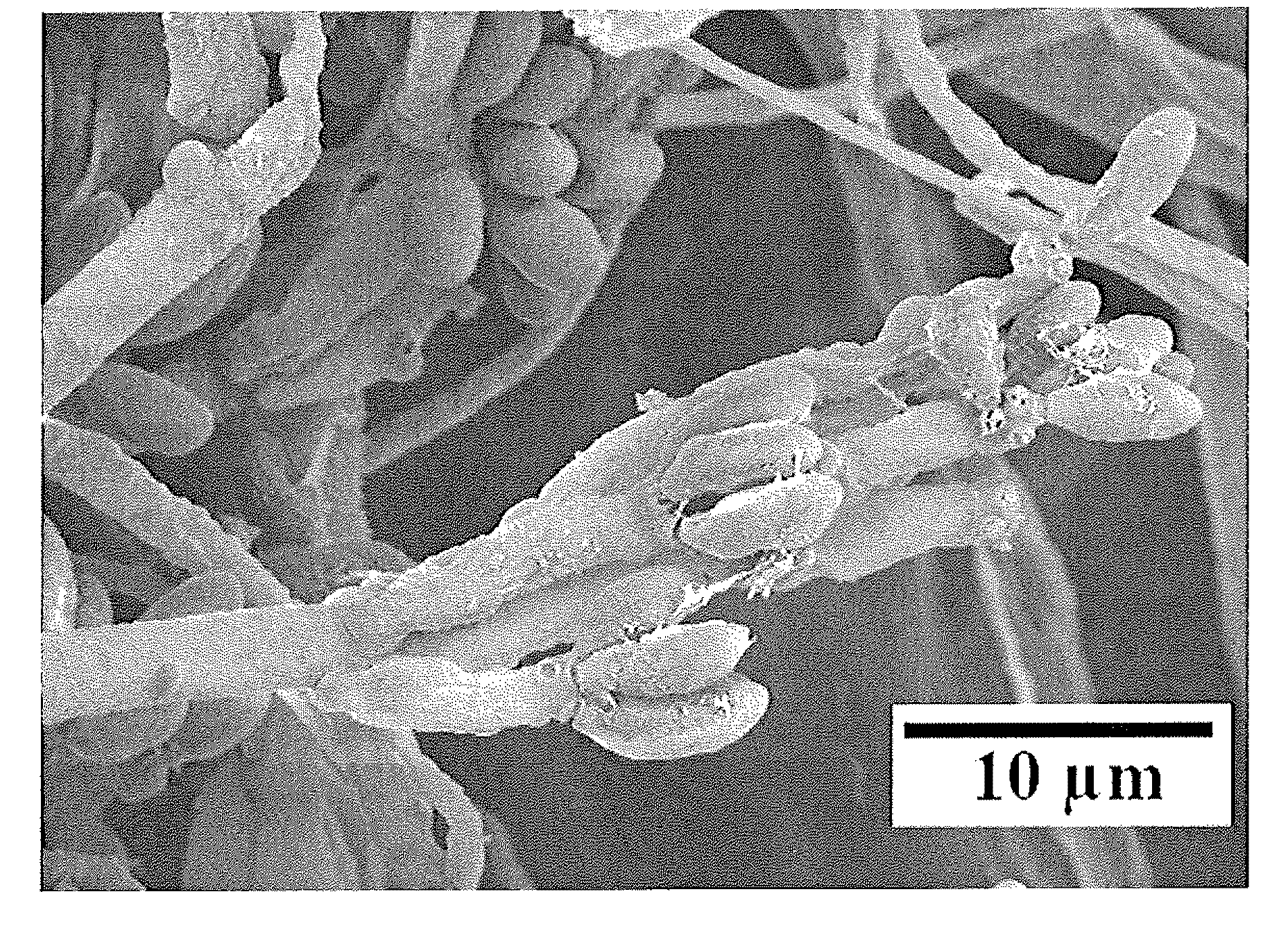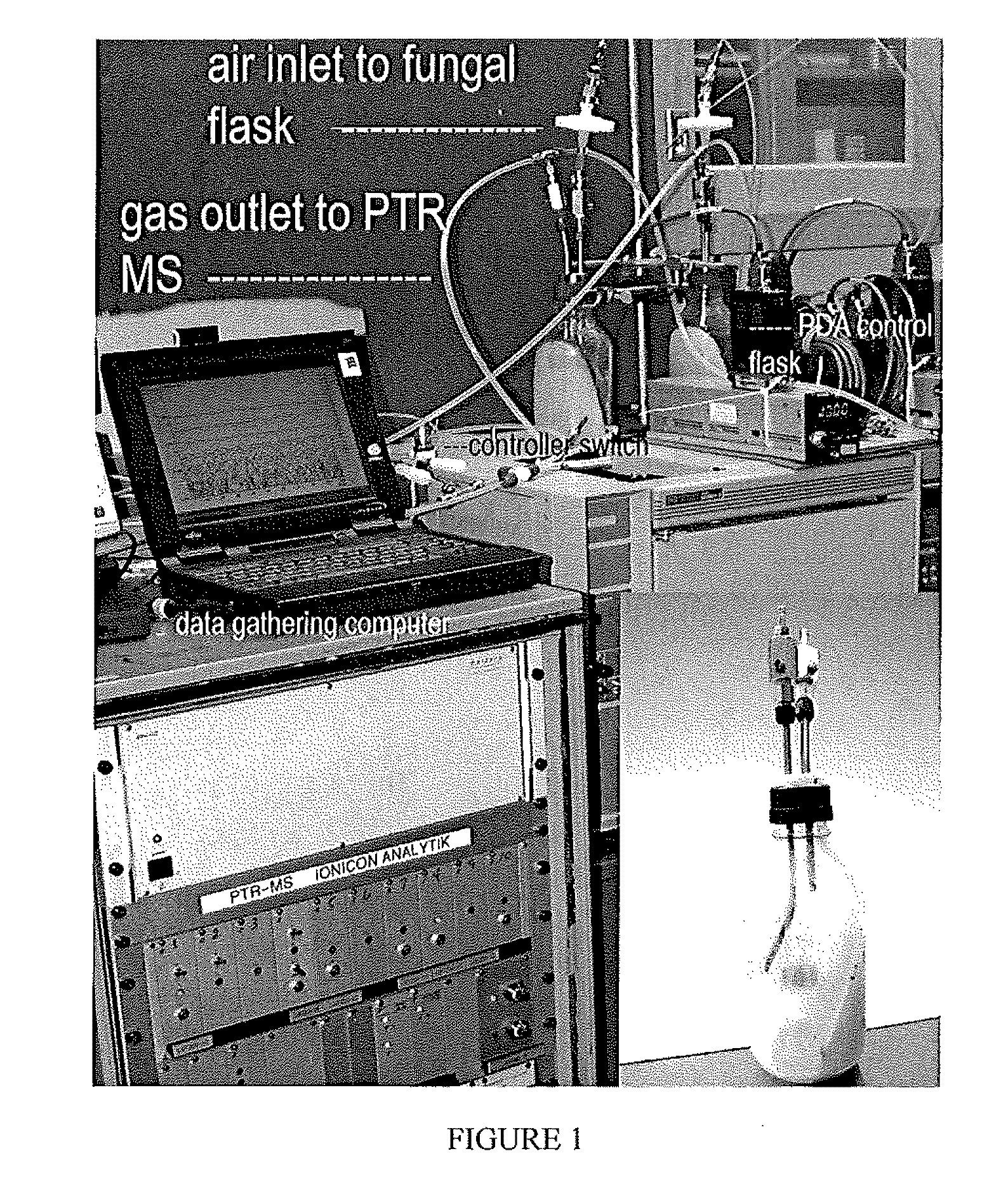System and Method of Producing Volatile Organic Compounds from Fungi
a technology of volatile organic compounds and fungi, which is applied in the field of system and method of producing volatile organic compounds from fungi, can solve the problems of major limiting factors in widespread industrial applications of these volatile compounds, and achieve the effects of increasing enhancing production rate or production amoun
- Summary
- Abstract
- Description
- Claims
- Application Information
AI Technical Summary
Benefits of technology
Problems solved by technology
Method used
Image
Examples
experimental examples
[0074]The invention is now described with reference to the following Examples. These Examples are provided for the purpose of illustration only and the invention should in no way be construed as being limited to these Examples, but rather should be construed to encompass any and all variations which become evident as a result of the teaching provided herein.
[0075]Without further description, it is believed that one of ordinary skill in the art can, using the preceding description and the following illustrative examples, make and utilize the present invention and practice the claimed methods. The following working examples therefore, specifically point out the preferred embodiments of the present invention, and are not to be construed as limiting in any way any portion of the disclosure.
Fungal Isolation and Storage
[0076]Endophytic fungal culture, CI-4, was obtained as an endophyte from an evergreen tree (Persea indica), native to the Canary Islands. One small limb was excised from Pe...
example 1
Biological Activities of the VOCs of Hypoxylon sp
[0087]The degree of susceptibility of the assay test organisms was dependent upon the age of the Hypoxylon sp. culture to which they were exposed for 24 hr (Table 1).
TABLE 1Progressive (time course) bioassay showing susceptibility of selected fungal pathogensto Hypoxylon sp. VOCs as a function of Hypoxylon sp. culture age with a 24 hr exposure to thefungal VOCs. The percentages reported are relative to growth of the test organism on a PDAplate minus Hypoxylon sp.Test Organism3 days4 days5 days6 days7 daysPhytophthora palmivora−16.6% ± 7.8 11.1% ± 0.0 88.8% ± 0.0100.0% ± 0.0100.0% ± 0.0Geotrichium candidum12.5% ± 0.0 6.2% ± 8.825.0% ± 0.0 31.2% ± 8.8 25.0% ± 17.6Rhizoctonia solani75.0% ± 35.375.0% ± 35.3 37.5% ± 53.0 87.5% ± 17.6100.0% ± 0.0Sclerotinia sclerotiorum28.5% ± 0.0 67.8% ± 15.1100.0% ± 0.0 100.0% ± 0.0100.0% ± 0.0Aspergillus fumigatus10.0% ± 14.140.0% ± 0.0 50.0% ± 14.1100.0% ± 0.0 75.0% ± 35.3Pythium ultimum−3.4% ± 4.9 ...
example 2
Composition of Volatiles Produced by Hypoxylon sp
[0089]Several GC / MS analyses were conducted on the VOCs produced by an eight day old culture of Hypoxylon sp. Controls consisting of uninoculated PDA Petri plates were used to subtract compounds contributed by the medium. Preliminary identification of fungal VOCs was determined by comparison of unknown volatiles with MS data of reference compounds listed in the NIST database. It is to be noted that the bulk of the VOCs could not be conclusively identified. However, for those VOCs which could be identified, authentic standards were used to confirm the identification of possible compounds and included 1,8-cineole and 1-methyl-1,4-cyclohexadiene. In addition, other compounds were tentatively identified on the basis of the % quality of the match to the NIST data base with an arbitrary cut off at 60% quality match. The most abundant compound, as based upon total integrated peak areas of the GC elution profile, was tentatively identified as...
PUM
| Property | Measurement | Unit |
|---|---|---|
| Mass | aaaaa | aaaaa |
| Mass | aaaaa | aaaaa |
| Mass | aaaaa | aaaaa |
Abstract
Description
Claims
Application Information
 Login to View More
Login to View More - R&D
- Intellectual Property
- Life Sciences
- Materials
- Tech Scout
- Unparalleled Data Quality
- Higher Quality Content
- 60% Fewer Hallucinations
Browse by: Latest US Patents, China's latest patents, Technical Efficacy Thesaurus, Application Domain, Technology Topic, Popular Technical Reports.
© 2025 PatSnap. All rights reserved.Legal|Privacy policy|Modern Slavery Act Transparency Statement|Sitemap|About US| Contact US: help@patsnap.com



